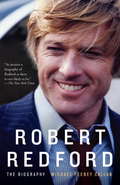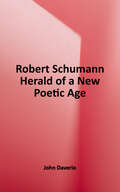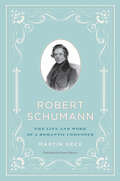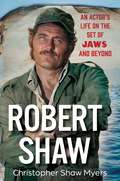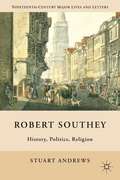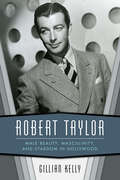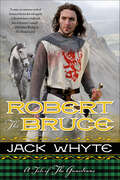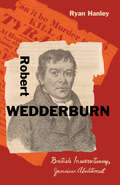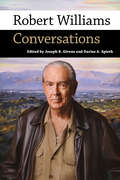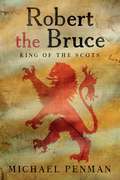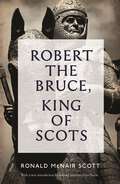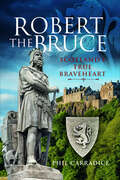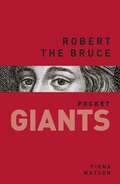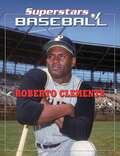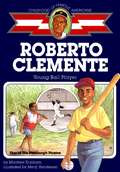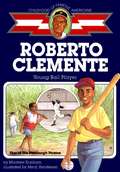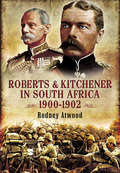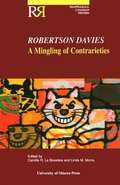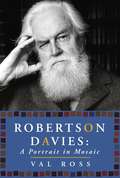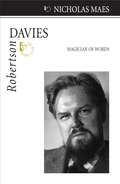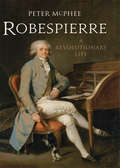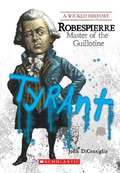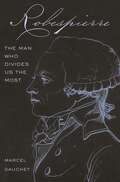- Table View
- List View
Robert Redford: The Biography
by Michael Feeney CallanThe long-anticipated biography of Robert Redford.Among the most widely admired Hollywood stars of his generation, Redford has appeared onstage and on-screen, in front of and behind the camera, earning Academy, Golden Globe, and a multitude of other awards and nominations for acting, directing, and producing, and for his contributions to the arts. His Sundance Film Festival transformed the world of filmmaking; his films defined a generation. America has come to know him as the Sundance Kid, Bob Woodward, Johnny Hooker, Jay Gatsby, and Roy Hobbs. But only now, with this revelatory biography, do we see the surprising and complex man beneath the Hollywood façade.From Redford's personal papers--journals, script notes, correspondence--and hundreds of hours of taped interviews, Michael Feeney Callan brings the legendary star into focus. Here is his scattered family background and restless childhood, his rocky start in acting, the death of his son, his star-making relationship with director Sydney Pollack, the creation of Sundance, his political activism, his artistic successes and failures, his friendships and romances. This is a candid, surprising portrait of a man whose iconic roles on-screen (Butch Cassidy and the Sundance Kid, All the President's Men, The Natural) and directorial brilliance (Ordinary People, Quiz Show) have both defined and obscured one of the most celebrated, and, until now, least understood, public figures of our time.From the Hardcover edition.
Robert Schumann: Herald of a "New Poetic Age"
by John DaverioForced by a hand injury to abandon a career as a pianist, Robert Schumann went on to become one of the world's great composers. Among many works, his Spring Symphony (1841), Piano Concerto in A Minor (1841/1845), and the Third, orRhenish, Symphony (1850) exemplify his infusion of classical forms with intense, personal emotion. His musical influence continues today and has inspired many other famous composers in the century since his death. Indeed Brahms, in a letter of January 1873, wrote: "The remembrance of Schumann is sacred to me. I will always take this noble pure artist as my model." <p><p>Now, in Robert Schumann: Herald of a "New Poetic Age,"John Daverio presents the first comprehensive study of the composer's life and works to appear in nearly a century. Long regarded as a quintessentially romantic figure, Schumann also has been portrayed as a profoundly tragic one: a composer who began his career as a genius and ended it as a mere talent. Daverio takes issue with this Schumann myth, arguing instead that the composer's entire creative life was guided by the desire to imbue music with the intellectual substance of literature. <p><p>A close analysis of the interdependence among Schumann's activities as reader, diarist, critic, and musician reveals the depth of his literary sensibility. Drawing on documents only recently brought to light, the author also provides a fresh outlook on the relationship between Schumann's mental illness—which brought on an extended sanitarium stay and eventual death in 1856—and his musical creativity. Schumann's character as man and artist thus emerges in all its complexity. The book concludes with an analysis of the late works and a postlude on Schumann's influence on successors from Brahms to Berg. <p><p>This well-researched study of Schumann interprets the composer's creative legacy in the context of his life and times, combining nineteenth-century cultural and intellectual history with a fascinating analysis of the works themselves.
Robert Schumann: The Life and Work of a Romantic Composer
by Martin GeckRobert Schumann (1810–56) is one of the most important and representative composers of the Romantic era. Born in Zwickau, Germany, Schumann began piano instruction at age seven and immediately developed a passion for music. When a permanent injury to his hand prevented him from pursuing a career as a touring concert pianist, he turned his energies and talents to composing, writing hundreds of works for piano and voice, as well as four symphonies and an opera. Here acclaimed biographer Martin Geck tells the fascinating story of this multifaceted genius, set in the context of the political and social revolutions of his time. The image of Schumann the man and the artist that emerges in Geck’s book is complex. Geck shows Schumann to be not only a major composer and music critic—he cofounded and wrote articles for the controversial Neue Zeitschrift für Musik—but also a political activist, the father of eight children, and an addict of mind-altering drugs. Through hard work and determination bordering on the obsessive, Schumann was able to control his demons and channel the tensions that seethed within him into music that mixes the popular and esoteric, resulting in compositions that require the creative engagement of reader and listener. The more we know about a composer, the more we hear his personality in his music, even if it is above all on the strength of his work that we love and admire him. Martin Geck’s book on Schumann is not just another rehashing of Schumann’s life and works, but an intelligent, personal interpretation of the composer as a musical, literary, and cultural personality.
Robert Shaw: An Actor's Life on the Set of JAWS and Beyond
by Christopher Shaw MyersRobert Shaw, the iconic star of Steven Spielberg&’s Jaws, comes boisterously to life in an up-close-and-personal biography that reveals the brilliant actor, esteemed playwright, prize-winning novelist, and loving and hard-living family man as never before.Robert Shaw unforgettably commanded attention as the weathered seaman Captain Quint in the blockbuster sensation, Jaws. But what came before and after that landmark film is as dramatic as the hunt for the great white shark itself.Capturing the many facets of the vibrant, generous, and sometimes polarizing man is his nephew, Christopher, who explores the forces that shaped a dynamic personality—including Robert&’s indomitable mother, his deeply troubled father, and his activist sister, Joanna, with whom Robert shared an unbreakable bond. Out of the traumatic events of their childhood in the Orkney Islands and Cornwall, Mrs. Shaw pushed her children to pursue their dreams. For Robert, that dream was acting and writing.Despite a storied career on the British and American stage—as both performer and playwright—and a string of hit films including From Russia with Love, A Man for All Seasons, The Sting, and The Taking of Pelham One Two Three, international celebrity eluded Robert . . . until he was summoned to star in &“a little horror film&” called Jaws.What happened on-screen was unforgettable. What happened off-screen was chaos. Now Christopher Shaw Myers reveals the true story of the making of the classic. Jaws would become both an artistic success and a worldwide triumph for Robert Shaw. Tragically, for a man shadowed by his father&’s demons, it would also signal the beginning of the end.Drawing on family recollections, personal letters, scrapbooks, recordings, extensive interviews, and a lifetime of his own memories, Christopher paints a unique, intimate, and honest portrait of a man he was proud to call his uncle.
Robert Southey
by Stuart AndrewsIn"Robert Southey," Andrews""argues that Robert Southey'sdenunciation of global Catholicism is essential to understanding his life, works, and times. On this issue, Southey was absolutely consistent - from his first visit to Lisbon in 1795-6 to his "Colloquies" published in 1829. The Poet Laureate's partisan rhetoric reflect its intensity and reveal a great deal about the religious culture of this stormy period in England. "
Robert Taylor: Male Beauty, Masculinity, and Stardom in Hollywood
by Gillian KellyBecause of his lengthy screen resume that includes almost eighty appearances in such movies as Camille and Waterloo Bridge, as well as a marriage and divorce to actress Barbara Stanwyck, Robert Taylor was a central figure of Hollywood’s classical era. Despite this, he can be regarded as a “lost” star, an interesting contradiction given the continued success he enjoyed during his lifetime. In Robert Taylor: Male Beauty, Masculinity, and Stardom in Hollywood, author Gillian Kelly investigates the initial construction and subsequent developments of Taylor's star persona across his thirty-five-year career. By examining concepts of male beauty, men as object of the erotic gaze, white American masculinity, and the unusual longevity of a career initially based on looks, Kelly highlights how gender, masculinity, and male stars and the ageing process affected Taylor's career. Placing Taylor within the histories of both Hollywood’s classical era and mid-twentieth-century America, this study positions him firmly within the wider industrial, cultural, and socioeconomic contexts in which he worked. Kelly examines Taylor’s film and television work as well as ephemeral material, such as fan magazines, to assess how his on- and off-screen personas were created and developed over time. Taking a mostly chronological approach, Kelly places Taylor’s persona within specific historical moments in order to show the complex paradox of his image remaining consistently recognizable while also shifting seamlessly within the Hollywood industry. Furthermore, she explores Taylor’s importance to Hollywood cinema by demonstrating how a star persona like his can “fit” so well, and for so long, that it almost becomes invisible and, eventually, almost forgotten.
Robert The Bruce: A Tale of the Guardians (The Guardians #2)
by Jack WhyteThe acclaimed author of The Forest Laird delivers “a bold, brash tribute to . . . one of medieval Scotland’s fiercest warriors and its most revered king” (Booklist).Robert I, or as he is known to a grateful Scottish nation, Robert the Bruce, was one of Scotland’s greatest kings, as well as one of the most famous warriors of his generation. He led the valiant Scots in the Wars of Scottish Independence against the Kingdom of England. His reign saw the recognition of Scotland as an independent nation, and today Bruce is remembered as a national hero. In this vividly detailed biographical novel, Jack Whyte brings this legend of history to gritty, passionate life.In the late thirteenth century, Robert and his father joined the rebellion against John Balliol, England’s appointed king of Scotland. Thus began his decades-long fight for Scottish freedom. He was a tireless campaigner in both battle and diplomacy. Finally, in May of 1328, King Edward III signed the Treaty of Edinburgh-Northampton, which recognized Scotland as an independent kingdom and Bruce as its king.
Robert Wedderburn: British Insurrectionary, Jamaican Abolitionist (Black Lives)
by Ryan HanleyThe first-ever biography of the ultra-radical thinker Robert Wedderburn, from his native Jamaica to metropole London, by an award-winning historian Robert Wedderburn (1762–1834/5) was one of the most charismatic, irascible, and radical intellectuals of the eighteenth- and early nineteenth-century Atlantic world. Born to an enslaved woman and a slavemaster in Jamaica, and moving in the radical working-class circles of London, Wedderburn made his name as a fiery political writer and orator—before dying, forgotten, in poverty. Among the few abolitionists bold enough to publicly call for the enslaved in the British West Indies to rise up and violently overthrow their colonial &“masters,&” Wedderburn was also among the most outspoken and—amid an increasingly repressive British establishment—dangerous advocates for domestic political reform and working-class rights. From award-winning scholar Ryan Hanley, this is the first full-length biography of a man increasingly recognized as central to Black radical political thought in the Revolutionary Atlantic. Tapping newly rediscovered sources, Hanley details Wedderburn&’s extraordinary public and private life, explores the central influence of enslaved women on his political ideas, and offers fresh analysis of his contributions to British political thought and activism.
Robert Williams: Conversations (Conversations with Comic Artists Series)
by Joseph R. Givens and Darius A. SpiethA legendary figure of underground comix, Robert Williams (b. 1943) is an important social chronicler of American popular culture. The interviews assembled in Robert Williams: Conversations attest to his rhetorical powers, which match the high level of energy evident in his underground comix and action-filled canvases.The public perception of Williams was largely defined by two events. In 1987, Guns N’ Roses licensed a Williams painting for the cover of their best-selling album Appetite for Destruction. However, Williams’s cover art stirred controversies and was moved to the inside of the album. The second defining event was Williams’s participation in the Helter Skelter exhibition at the Los Angeles Museum of Contemporary Art in 1992. Protests ensued when a room was set aside to feature his work. Uncovering long-forgotten and hard-to-find interviews, this collection serves as a social chronicle of counterculture from the 1960s through the early 2000s. One of the founders of the original ZAP Comix collective in the 1960s, Williams drew inspiration from pulp fiction, hot rod culture, pin-up girls, and traditional academic art. He invented the comics character Cootchy Cooty and worked for the studios of Ed “Big Daddy” Roth. He rubbed shoulders with outlaw motorcycle gangs and tested the legal limits of what was permissible comic book art during his day. He has often been described as a figure courting scandal and controversy, a reputation he discusses repeatedly in some of the interviews here. Since the 1980s, Williams has emerged as a force in the fine art world, raising interesting questions about how painting and comic art interrelate.
Robert the Bruce
by Michael PenmanRobert the Bruce (1274-1329) famously defeated the English at Bannockburn and became the hero king responsible for Scottish independence. In this fascinating new biography of the renowned warrior, Michael Penman focuses on Robert's kingship in the fifteen years that followed his triumphant victory and establishes Robert as not only a great military leader but a great monarch. Robert faced a slow and often troubled process of legitimating his authority, restoring government, rewarding his supporters, accommodating former enemies, and controlling the various regions of his kingdom, none of which was achieved overnight. Penman investigates Robert's resettlement of lands and offices, the development of Scotland's parliaments, his handling of plots to overthrow him, his relations with his family and allies, his piety and court ethos, and his conscious development of an image of kingship through the use of ceremony and symbol. In doing so, Penman repositions Robert within the context of wider European political change, religion, culture, and national identity as well as recurrent crises of famine and disease.
Robert the Bruce, King of Scots: King of Scots
by Ronald McNair Scott&“A heroic biography of one of Scotland's legendary leaders, by a British novelist and former literary critic for the London Sunday Times&” (Kirkus). Robert the Bruce had himself crowned King of Scots at Scone on a frozen March morning in 1306. After years of struggle, Scotland had been reduced to a vassal state by Edward I of England. Its people lived in abject poverty. But on the day he seized the crown, Bruce renewed the fight for Scotland&’s freedom, and let forth a battle cry that would echo through the centuries. Using contemporary accounts, Ronald McNair Scott tells the story of Scotland&’s legendary 14th century leader, and one of Europe&’s most remarkable medieval kings. From Bruce&’s historic victory against England in the Battle of Bannockburn to the day in 1324 when the Pope recognized him as king of an independent Scotland, this is a story of a man whose life shaped a nation.&“A thundering good narrative … splendidly told.&”—Sunday Telegraph, UK
Robert the Bruce: Scotland's True Braveheart
by Phil CarradiceRobert the Bruce is a detailed account of the life and times of the Scottish hero and monarch. It covers his life from childhood to death, looking at the political, social and military life of Scotland before, during and after the time of Robert the Bruce. The book looks at the relationship between The Bruce and people like Edward I and Edward II of England, William Wallace and the other contenders for the Scottish crown. The main thrust of the book is a chronological account of how The Bruce clawed his way to power, his struggles and battles and his eventual victory which gave Scotland independence and freedom from an acquisitive and warlike neighbour. It looks in detail at the murder of John Comyn, of which The Bruce stood accused, and the political ramifications of the killing. Robert the Bruce was no saint. He was a ruthless, cunning warrior, a man of his times, dedicated to what he saw as his mission in life. Flawed he may have been but he was also a great King, a worthy warrior and a man who deserves to emerge from the shadow of William Wallace - a position to which he has been relegated ever since the film Braveheart.
Robert the Bruce: pocket GIANTS (Pocket GIANTS)
by Fiona WatsonFrom disastrous beginnings after he took the throne of Scotland, having murdered a powerful rival, Robert I became a military leader of consummate genius. Throwing away the rulebook of medieval warfare, which favoured the mounted knight, he remodelled the Scottish army as a disciplined, audacious band of brothers capable of surprising castles, raiding and extracting blackmail as far south as Yorkshire and even defeating a mighty English army in pitched battle. Ruthless, charismatic, indomitable and lucky, the ‘Bruce’ is a towering example of an underdog capable of turning disadvantage into advantage and winning the day through talent and sheer determination. The English turned the lessons they learnt from him to good effect in their Hundred Years war against France.
Roberto Clemente (Superstars of Baseball)
by Tania RodriguezNot many baseball players are as legendary as Roberto Clemente. He broke color barriers. He gave back to his community. And through it all, he played great baseball. During his career with the Pittsburgh Pirates, he did some amazing things. Sadly, Clemente's life was cut short by a plane crash. Today, however, his memory lives on. Fans everywhere still think of the player from Puerto Rico as an inspiration to us all.
Roberto Clemente: Orgullo de los Piratas de Pittsburgh
by Jonah Winter Raúl ColónNIMAC-sourced textbook
Roberto Clemente: Pride of the Pittsburgh Pirates
by Jonah WinterOn an island called Puerto Rico, there lived a little boy who wanted only to play baseball. Although he had no money, Roberto Clemente practiced and practiced until--eventually--he made it to the Major Leagues. America! As a right-fielder for the Pittsburgh Pirates, he fought tough opponents--and even tougher racism--but with his unreal catches and swift feet, he earned his nickname, "The Great One." He led the Pirates to two World Series, hit 3,000 hits, and was the first Latino to be inducted into the Hall of Fame. But it wasn't just baseball that made Clemente legendary--he was was also a humanitarian dedicated to improving the lives of others.
Roberto Clemente: Young Baseball Player
by Meryl Henderson Montrew DunhamTraces the personal life and baseball career of the Puerto Rican baseball superstar, from his childhood love of the game through his professional career and untimely death to his election to the Hall of Fame in 1973.
Roberto Clemente: Young Baseball Player (Childhood of Famous Americans Series)
by Montrew DunhamThis inspirational account of one of Puerto Rico's -- and America's -- most beloved heroes explores the early years of a man who was both a Hall of Fame right fielder and a courageous humanitarian.
Roberts & Kitchener in South Africa, 1900–1902: 1900-1902
by Rodney AtwoodThe British Army was shocked by three military defeats in a week in South Africa in late 1899. The commanding General Sir Redvers Buller lost his nerve. Something must be done was the cry across the Empire. Britain sent forth not one, but two military heroes. Field Marshal Lord Roberts and Major General Lord Kitchener spent their first five weeks in South Africa restoring morale, reorganising their forces and deceiving the enemy as to their intentions. In the next four weeks their offensive transformed the war: Kimberley and Ladysmith were relieved from Boer sieges and an enemy force of 4000 under General Cronje was captured on the Modder River. A long and bitter guerrilla war ensured in a terrain ideally suited to fast-moving Boer commandoes. On the dark side, deeds were committed of which no civilised empire priding itself on justice and fair play could be proud. The comradeship-in-arms of Roberts and Kitchener, their differing yet complementary personalities, their strategic and tactical decisions are described and assessed using a wide variety of sources including, personal papers and official correspondence. By these mens resourcefulness the British Army, despite its unpreparedness and poor leadership at many levels, won a remarkable victory in the first of the twentieth century Peoples Wars.
Robertson Davies: A Mingling of Contrarieties
by Camille R. La Bossiere Linda M. MorraThis collection of essays on the writing of Robertson Davies addresses the basic problems in reading his work by looking at the topics of doubling, disguise, irony, paradox, and dwelling in "gaps" or spaces "in between."
Robertson Davies: A Portrait in Mosaic
by Val RossNational bestseller and a Globe and Mail Best Book A fascinating, larger-than-life character, Davies left a treasure trove of stories about him when he died in 1995 -- expertly arranged here into a revealing portrait.From his student days onward, Robertson Davies made a huge impression on those around him. He was so clearly bound for a glorious future that some young friends even carefully preserved his letters. And everyone remembered their encounters with him.Later in life, as a world-famous writer, perhaps Canada's pre-eminent man of letters (who "looked like Jehovah"), he attracted people eager to meet him, who also vividly remembered their meetings. So when Val Ross set out in search of people's memories, she was faced with a wonderful embarrassment of riches. The one hundred or so contributors here range very widely. There are family memories, of course, and memories from colleagues in the academic world who knew him as a professor and the founding master of Massey College at the University of Toronto.Predictably, there are other major writers like Margaret Atwood and John Irving. Less predictably, there are people from the world of Hollywood, such as Norman Jewison and David Cronenberg (who remembers Davies on-set, peering through a camera lens as he researched his newest novel). And we even hear from his barber, and from his gardener, Theo Henkenhaf.Some speakers contribute just a lively paragraph; others several pages. Yet all of them, through the magic of Val Ross's art, help to create an intriguing, full-colour portrait of a complex man beloved by millions of readers around the world.From the Hardcover edition.
Robertson Davies: Magician of Words
by Nicholas MaesBorn in Thamesville, Ontario, a student at Queen’s University in Kingston in the 1930’s, and editor and later publisher of the Peterborough Examiner from the 1940s to the mid-1960s, playwright, essayist, critic, professor, and novelist Robertson Davies (1913-1995) was one of Canada’s pre-eminent literary voices for more than a half-century. Davies, with his generous beard and donnish manner, was the very epitome of the "man of letters," a term he abhorred. Best known for his Deptford Trilogy of novels (Fifth Business, The Manticore, World of Wonders), he also wrote two other trilogies (Salterton and Cornish) and was at work on the third volume of another trilogy (Toronto) when he died. With a life as rich in character and colour as that found in his fiction and essays, Davies had a great fondness for magic and myth, both of which are found in abundance in his work, along with a prodigious streak of wry humour.
Robespierre
by Peter McpheeFor some historians and biographers, Maximilien Robespierre (1758-94) was a great revolutionary martyr who succeeded in leading the French Republic to safety in the face of overwhelming military odds. For many others, he was the first modern dictator, a fanatic who instigated the murderous Reign of Terror in 1793-94. This masterful biography combines new research into Robespierre's dramatic life with a deep understanding of society and the politics of the French Revolution to arrive at a fresh understanding of the man, his passions, and his tragic shortcomings. Peter McPhee gives special attention to Robespierre's formative years and the development of an iron will in a frail boy conceived outside wedlock and on the margins of polite provincial society. Exploring how these experiences formed the young lawyer who arrived in Versailles in 1789, the author discovers not the cold, obsessive Robespierre of legend, but a man of passion with close but platonic friendships with women. Soon immersed in revolutionary conflict, he suffered increasingly lengthy periods of nervous collapse correlating with moments of political crisis, yet Robespierre was tragically unable to step away from the crushing burdens of leadership. Did his ruthless, uncompromising exercise of power reflect a descent into madness in his final year of life? McPhee reevaluates the ideology and reality of "the Terror," what Robespierre intended, and whether it represented an abandonment or a reversal of his early liberalism and sense of justice.
Robespierre: Master of the Guillotine
by John DiconsiglioWas Robespierre a bloodthirsty tyrant or a misunderstood man of virtue? Follow the French Revolution's most notorious leader from his "incorruptible" beginnings to his end on the guillotine.
Robespierre: The Man Who Divides Us the Most
by Marcel GauchetHow Robespierre’s career and legacy embody the dangerous contradictions of democracyMaximilien Robespierre (1758–1794) is arguably the most controversial and contradictory figure of the French Revolution, inspiring passionate debate like no other protagonist of those dramatic and violent events. The fervor of those who defend Robespierre the “Incorruptible,” who championed the rights of the people, is met with revulsion by those who condemn him as the bloodthirsty tyrant who sent people to the guillotine. Marcel Gauchet argues that he was both, embodying the glorious achievement of liberty as well as the excesses that culminated in the Terror.In much the same way that 1789 and 1793 symbolize the two opposing faces of the French Revolution, Robespierre’s contradictions were the contradictions of the revolution itself. Robespierre was its purest incarnation, neither the defender of liberty who fell victim to the corrupting influence of power nor the tyrant who betrayed the principles of the revolution. Gauchet shows how Robespierre’s personal transition from opposition to governance was itself an expression of the tragedy inherent in a revolution whose own prophetic ideals were impossible to implement.This panoramic book tells the story of how the man most associated with the founding of modern French democracy was also the first tyrant of that democracy, and it offers vital lessons for all democracies about the perpetual danger of tyranny.
